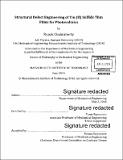Structural defect engineering of tin (II) sulfide thin films for photovoltaics
Author(s)
Chakraborty, Rupak
DownloadFull printable version (17.79Mb)
Alternative title
Structural defect engineering of SnS thin films for photovoltaics
Other Contributors
Massachusetts Institute of Technology. Department of Mechanical Engineering.
Advisor
Tonio Buonassisi.
Terms of use
Metadata
Show full item recordAbstract
Tin (II) sulfide (SnS) is a promising Earth-abundant, non-toxic alternative to commercially available thin-film photovoltaic (PV) materials because of its near-ideal bandgap, high absorption coefficient, and potential for facile manufacturing. However, SnS-based photovoltaic devices have reached a maximum experimental efficiency of only 4.4%, compared to a theoretical maximum of 32%, primarily due to a low minority-carrier lifetime. In this work, I assess the impact of structural defects and anisotropy on the minority-carrier lifetime and other key device parameters, shedding light on the path to high-efficiency SnS-based photovoltaics. SnS thin films are deposited by thermal evaporation in a range of growth temperatures with varying structural defect density. Extended structural defects including intragranular defects and grain boundaries are directly related to minority-carrier collection length using high-resolution correlative electron microscopy. The results suggest that intragranular point defects, as opposed to extended structural defects, are likely responsible for the short minority-carrier lifetimes in present-day SnS films. Inhomogeneities in the polycrystalline SnS thin films due to the anisotropic material properties of SnS may also impact the device performance. Device simulations taking into account the orientation-dependent electron affinity of SnS show that a uniform grain orientation distribution is optimal. As a route toward both uniform grain orientation and low structural defect density, the anisotropic surface energy of SnS is harnessed by growth on a van der Waals-terminated substrate. An enhancement in both orientation uniformity and minority-carrier lifetime is measured, showing a promising path toward the ideal SnS film. Lastly, the process of optimization to reduce structural defect density may be expedited by in-situ characterization of micro- and nanoscale defects under realistic processing conditions. Toward this end, an in-situ temperature stage for synchrotron X-ray spectromicrosopy is developed to track nanoscale defects up to a sample temperature of 600°C. The stage enables previously unattainable in-situ studies of defect kinetics, allowing both a deeper understanding of how process conditions affect defect characteristics and the ability to rapidly optimize process conditions toward a defect-free film.
Description
Thesis: Ph. D., Massachusetts Institute of Technology, Department of Mechanical Engineering, 2016. This electronic version was submitted by the student author. The certified thesis is available in the Institute Archives and Special Collections. Cataloged from PDF version of thesis. Includes bibliographical references (pages 126-137).
Date issued
2016Department
Massachusetts Institute of Technology. Department of Mechanical EngineeringPublisher
Massachusetts Institute of Technology
Keywords
Mechanical Engineering.